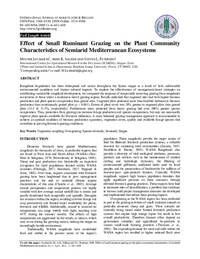Effect of Small Ruminant Grazing on the Plant Community Characteristics of Semiarid Mediterranean Ecosystems

Authors:
Rangeland degradation has been widespread and severe throughout the Syrian steppe as a result of both unfavorable environmental conditions and human induced impacts. To explore the effectiveness of management-based strategies on establishing sustainable rangeland development, we compared the response of temporarily removing grazing from rangelands ecosystems to those under a continuous heavy grazing regime. Results indicated that ungrazed sites had both higher biomass production and plant species composition than grazed sites. Ungrazed plots produced more than fourfold herbaceous biomass production than continuously grazed plots (p < 0.001). Extent of plant cover was 20% greater in ungrazed plots than grazed plots (33.5 & 13.5%, respectively). Furthermore areas protected from heavy grazing had over 200% greater species composition. Thus, protection from grazing can increase forage production and species composition, but may not necessarily improve plant species available for livestock utilization. A more balanced grazing management approach is recommended to achieve an optimal condition of biomass production (quantity), vegetation cover, quality and available forage species that contribute to proving livestock grazing conditions.
